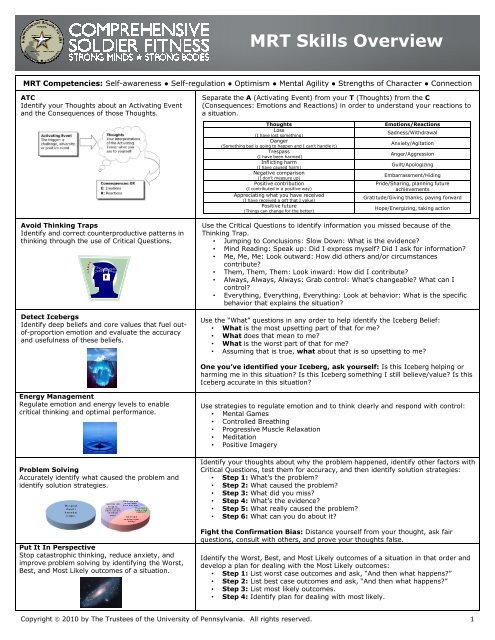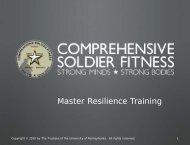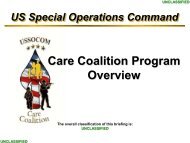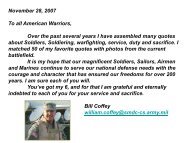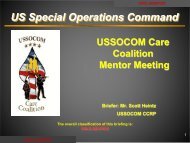MRT Skills Overview - 9Line LLC
MRT Skills Overview - 9Line LLC
MRT Skills Overview - 9Line LLC
Create successful ePaper yourself
Turn your PDF publications into a flip-book with our unique Google optimized e-Paper software.
<strong>MRT</strong> <strong>Skills</strong> <strong>Overview</strong><br />
<strong>MRT</strong> Competencies: Self-awareness ● Self-regulation ● Optimism ● Mental Agility ● Strengths of Character ● Connection<br />
ATC<br />
Identify your Thoughts about an Activating Event<br />
and the Consequences of those Thoughts.<br />
Avoid Thinking Traps<br />
Identify and correct counterproductive patterns in<br />
thinking through the use of Critical Questions.<br />
Detect Icebergs<br />
Identify deep beliefs and core values that fuel outof-proportion<br />
emotion and evaluate the accuracy<br />
and usefulness of these beliefs.<br />
Energy Management<br />
Regulate emotion and energy levels to enable<br />
critical thinking and optimal performance.<br />
Problem Solving<br />
Accurately identify what caused the problem and<br />
identify solution strategies.<br />
My squ ad<br />
d oesn' t<br />
h ave wh at<br />
i t takes.<br />
I som etimes rush<br />
th ro ugh my<br />
descrip tio n o f th e<br />
objec tiv e and do n’t<br />
com municate<br />
clearly.*<br />
This is a n ew sq uad<br />
an d my S oldiers<br />
h av e a lo t to lea rn.<br />
Private Smith is<br />
having a rough<br />
trans itio n. *<br />
I hav en't spe nt<br />
mu ch time o n team<br />
build in g.*<br />
Put It In Perspective<br />
Stop catastrophic thinking, reduce anxiety, and<br />
improve problem solving by identifying the Worst,<br />
Best, and Most Likely outcomes of a situation.<br />
Separate the A (Activating Event) from your T (Thoughts) from the C<br />
(Consequences: Emotions and Reactions) in order to understand your reactions to<br />
a situation.<br />
Thoughts Emotions/Reactions<br />
Loss<br />
(I have lost something)<br />
Sadness/Withdrawal<br />
Danger<br />
(Something bad is going to happen and I can’t handle it)<br />
Anxiety/Agitation<br />
Trespass<br />
(I have been harmed)<br />
Anger/Aggression<br />
Inflicting harm<br />
(I have caused harm)<br />
Guilt/Apologizing<br />
Negative comparison<br />
(I don’t measure up)<br />
Embarrassment/Hiding<br />
Positive contribution<br />
(I contributed in a positive way)<br />
Appreciating what you have received<br />
(I have received a gift that I value)<br />
Positive future<br />
(Things can change for the better)<br />
Copyright © 2010 by The Trustees of the University of Pennsylvania. All rights reserved.<br />
Pride/Sharing, planning future<br />
achievements<br />
Gratitude/Giving thanks, paying forward<br />
Hope/Energizing, taking action<br />
Use the Critical Questions to identify information you missed because of the<br />
Thinking Trap.<br />
• Jumping to Conclusions: Slow Down: What is the evidence?<br />
• Mind Reading: Speak up: Did I express myself? Did I ask for information?<br />
• Me, Me, Me: Look outward: How did others and/or circumstances<br />
contribute?<br />
• Them, Them, Them: Look inward: How did I contribute?<br />
• Always, Always, Always: Grab control: What’s changeable? What can I<br />
control?<br />
• Everything, Everything, Everything: Look at behavior: What is the specific<br />
behavior that explains the situation?<br />
Use the “What” questions in any order to help identify the Iceberg Belief:<br />
• What is the most upsetting part of that for me?<br />
• What does that mean to me?<br />
• What is the worst part of that for me?<br />
• Assuming that is true, what about that is so upsetting to me?<br />
One you’ve identified your Iceberg, ask yourself: Is this Iceberg helping or<br />
harming me in this situation? Is this Iceberg something I still believe/value? Is this<br />
Iceberg accurate in this situation?<br />
Use strategies to regulate emotion and to think clearly and respond with control:<br />
• Mental Games<br />
• Controlled Breathing<br />
• Progressive Muscle Relaxation<br />
• Meditation<br />
• Positive Imagery<br />
Identify your thoughts about why the problem happened, identify other factors with<br />
Critical Questions, test them for accuracy, and then identify solution strategies:<br />
• Step 1: What’s the problem?<br />
• Step 2: What caused the problem?<br />
• Step 3: What did you miss?<br />
• Step 4: What’s the evidence?<br />
• Step 5: What really caused the problem?<br />
• Step 6: What can you do about it?<br />
Fight the Confirmation Bias: Distance yourself from your thought, ask fair<br />
questions, consult with others, and prove your thoughts false.<br />
Identify the Worst, Best, and Most Likely outcomes of a situation in that order and<br />
develop a plan for dealing with the Most Likely outcomes:<br />
• Step 1: List worst case outcomes and ask, “And then what happens?”<br />
• Step 2: List best case outcomes and ask, “And then what happens?”<br />
• Step 3: List most likely outcomes.<br />
• Step 4: Identify plan for dealing with most likely.<br />
1
Real-time Resilience<br />
Shut down counterproductive thinking to enable<br />
greater concentration and focus on the task at<br />
hand.<br />
Identify Strengths in Self and Others<br />
Identify strengths in yourself and in others to build<br />
on the best of yourself and the best of others.<br />
Kindness Kindness<br />
Kindness<br />
<strong>MRT</strong> <strong>Skills</strong> <strong>Overview</strong><br />
Fight back against counterproductive thoughts by using the sentence starters:<br />
• That’s not completely true because…(evidence)<br />
• A more optimistic way of seeing this is…(optimism)<br />
• The most likely implication is…and I can…(perspective)<br />
• Avoid the common pitfalls: Dismissing the grain of truth, minimizing the<br />
situation, rationalizing or excusing one’s contribution to a problem<br />
Identify your top Character Strengths and those of others and identify ways to use<br />
your strengths to increase your effectiveness and strengthen your relationships.<br />
VIA Character Strengths: Appreciation of beauty and excellence ● Bravery ●<br />
Capacity to love ● Caution, prudence ● Citizenship, teamwork ● Creativity ●<br />
Curiosity ● Fairness ● Forgiveness ● Gratitude ● Honesty ● Hope ● Humor ●<br />
Industry, perseverance ● Judgment, critical thinking ● Kindness ● Leadership ●<br />
Love of learning ● Modesty ● Perspective ● Self-control ● Social intelligence ●<br />
Spirituality, sense of purpose ● Zest<br />
Use Strengths in Challenges<br />
Identify strengths in yourself and in others to<br />
improve teamwork and overcome challenges. Identify the specific actions that flow from your strengths in challenges and in<br />
successes:<br />
• Step 1: Name the strength that you used or will use.<br />
• Step 2: How did you or will you use that strength to deal with the<br />
challenge?<br />
• Step 3: Draw on strengths of team members for complex challenges.<br />
Assertive Communication<br />
Communicate clearly and with respect, especially<br />
during a conflict or challenge. Use the IDEAL model<br />
to communicate in a Confident, Clear, and<br />
Controlled manner.<br />
Active Constructive Responding and Praise<br />
Respond to others with authentic, active and<br />
constructive interest to build strong relationships.<br />
Praise to build mastery and winning streaks.<br />
Hunt the Good Stuff<br />
Hunt the Good Stuff to counter the negativity bias,<br />
to create positive emotion, and to notice and<br />
analyze what is good.<br />
Copyright © 2010 by The Trustees of the University of Pennsylvania. All rights reserved.<br />
Use the IDEAL Model to communicate assertively:<br />
• I = Identify and understand the problem<br />
• D = Describe the problem objectively<br />
• E = Express your concerns and how you feel<br />
• A = Ask the other person for his/her perspective and ask for a reasonable<br />
change<br />
• L = List the consequences<br />
Active Constructive Responding is authentic, constructive interest. It helps the<br />
other person to savor their positive experience and leaves them feeling validated<br />
and understood. Create “winning streaks” by using Praise to name strategies,<br />
processes, or behaviors that led to the good outcome.<br />
Active<br />
Passive<br />
Constructive Destructive<br />
Authentic interest, elaborates the<br />
experience; person feels validated<br />
and understood<br />
Quiet, understated support;<br />
conversation fizzles out; person<br />
feels unimportant, misunderstood,<br />
embarrassed, or guilty<br />
Squashing the event, brings conversation<br />
to a halt; person feels ashamed,<br />
embarrassed, guilty, or angry<br />
Ignoring the event; conversation never<br />
starts; person feels confused, guilty, or<br />
disappointed<br />
Record three good things each day and write a reflection next to each positive<br />
event about:<br />
• Why this good thing happened<br />
• What this good thing means to you<br />
• What you can do tomorrow to enable more of this good thing<br />
• What ways you or others contribute to this good thing<br />
2


